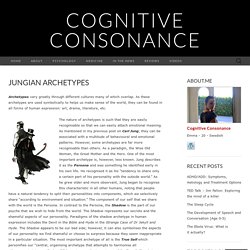

The 12 Common Archetypes. The 12 Common Archetypes By Carl Golden The term "archetype" has its origins in ancient Greek.

The root words are archein, which means "original or old"; and typos, which means "pattern, model or type". The combined meaning is an "original pattern" of which all other similar persons, objects, or concepts are derived, copied, modeled, or emulated. The psychologist, Carl Gustav Jung, used the concept of archetype in his theory of the human psyche. Although there are many different archetypes, Jung defined twelve primary types that symbolize basic human motivations. Most, if not all, people have several archetypes at play in their personality construct; however, one archetype tends to dominate the personality in general.
Return Home. Cognitive Consonance. Archetypes vary greatly through different cultures many of which overlap.

As these archetypes are used symbolically to helps us make sense of the world, they can be found in all forms of human expression: art, drama, literature, etc. The nature of archetypes is such that they are easily recognisable so that we can easily attach emotional meaning. As mentioned in my previous post on Carl Jung, they can be associated with a multitude of behavioural and emotional patterns. However, some archetypes are far more recognisable than others. As a paradigm, the Wise Old Woman, the Great Mother and the Hero.
Furthermore, Jung believed that our self is composed of both masculine and feminine parts, which becomes molded into a fully male or female form by society and biology. In our society and culture, the Animus is represented as the real man: muscular, commanding, logical, the solider and romantic seducer. Archetypes play a key role in the dream interpretation involved in psychoanalysis. Citation: Top Carl Jung’s quotes. 37 Practices of a Bodhisattva.
Spiritual Things. 6 Signs You’re Not In Touch With Your Personal Wisdom (And How To Fix It) “Know well what leads you forward and what holds you back, and choose the path that leads to wisdom.” – Buddha While this advice from “the enlightened one” may be easier said than done, it’s safe to say that we have all embarked on our own journeys toward personal wisdom in one way or another.

It’s more a matter of how far we’ve come, where we hope to be, and the obstacles currently remaining in the way. Unfortunately, inner wisdom isn’t something that we can learn from a textbook, lecture or lesson. We simply (or not so simply) have to live it. In his 1922 pioneering piece on senescence, G. The throws of daily life often lead us astray from these characteristics that we need to focus on, leaving us out of touch with our true selves.
Here are 6 ways you could be standing in the way of your own personal wisdom without even realizing it. You’re quick to judge a book by its cover. Preconceived notions about the world and all that it encompasses are like locks on the door to personal wisdom. 10 Happiness Hacks: Backed By Science. Huffington Post| I would love to be happier, as I’m sure most people would, so I thought it would be interesting to find some ways to become a happier person that are actually backed up by science.

Here are ten of the best ones I found. 1. Exercise more – 7 minutes might be enough You might have seen some talk recently about the scientific 7 minute workout mentioned in The New York Times. So if you thought exercise was something you didn’t have time for, maybe you can fit it in after all. The groups were then tested six months later to assess their relapse rate.
You don’t have to be depressed to gain benefit from exercise, though. A study in the Journal of Health Psychology found that people who exercised felt better about their bodies, even when they saw no physical changes: Body weight, shape and body image were assessed in 16 males and 18 females before and after both 6 × 40 mins exercise and 6 × 40 mins reading. 2. 3. 4.